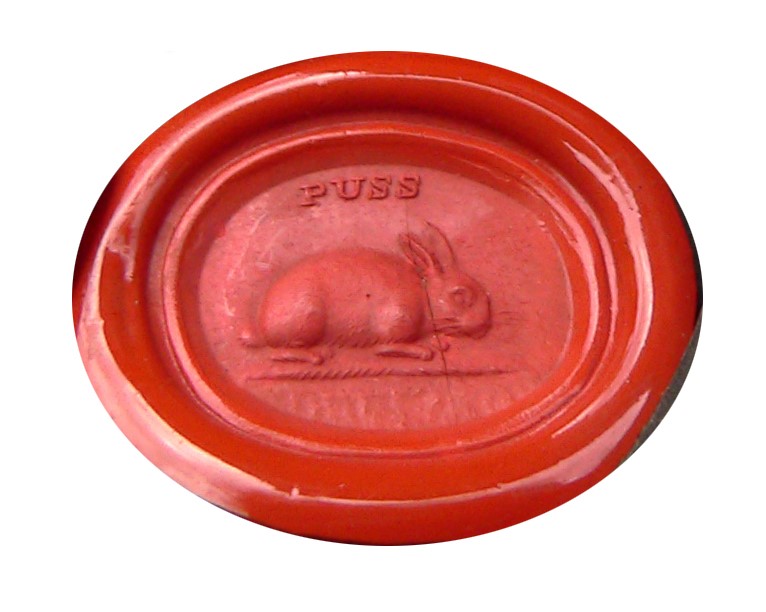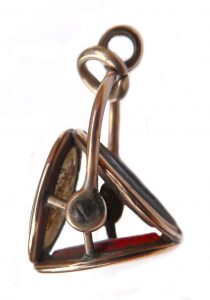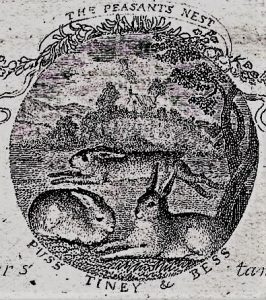Cowper’s three hares – Puss, Tiney and Bess – soon became an integral part of his life story and have remained so. Two of the earliest representations of them appear on a three-seal fob and a snuff box, both on display in the museum.
The seal fob dates from the reign of George III (1760-1820) and belonged to Lady Harriot Hesketh, Cowper’s cousin, while the snuff box, with the hares painted on the lid, was given him by his one-time fiancée, and Harriot’s sister, Theadora Cowper.
It is clear from Cowper’s writings, and from these two pieces of valuable memorabilia, that Cowper took a very close and special interest in his hares, their nature and nurture
Cowper’s hare-keeping
Cowper published a famous letter in The Gentleman’s Magazine about his hares, giving us a vivid picture of their characters, habits and – importantly – their diet. It is justly renowned for its fascinating, well-observed and accurate information about the needs and habits of hares as a species. But it is also a lovely example of Cowper’s engaging prose style: he clearly delights in describing the individual character of each of his three hares; and his obvious pleasure in their companionship and in their independence is something many of us will recognise from our own knowledge of pet-keeping.
Here he is on Puss, who
…grew presently familiar, would leap into my lap, raise himself upon his hinder feet, and bite the hair from my temples. He would suffer me to take him up and to carry him about in my arms, and has more than once fallen asleep upon my knee… I made it my custom to carry him always after breakfast into the garden, where he hid himself generally under the leaves of a cucumber vine, sleeping or chewing the cud till evening; in the leaves also of that vine he found a favourite repast.
As for Tiney,
Upon him the kindest treatment had not the least effect… He was, however, very entertaining in his way, even his surliness was matter of mirth, and in his play he preserved such an air of gravity, and performed his feats with such a solemnity of manner, that in him too I had an agreeable companion.
These two short extracts give a brief taste of the affection and humour with which Cowper writes about his pets. The full text is a delight to read, and may be found here in our article, The History of My Three Hares.
Many of us today probably find it curious that Cowper (or indeed anyone) would try to domesticate hares. What might they be like as pets? Was Cowper’s project unusual? The answer to the last question seems likely to be ‘yes’ since Cowper took the trouble to write such a detailed account for publication.
The contents of the letter help to explain the contemporary interest (as well as the gifts) that Cowper’s hare-keeping generated. It helps us also to recognise the significance of these animals, and probably the others that he kept, for his well-being.
The seal fob
The three-seal fob is of special interest to the museum as each seal is carved with a representation of one of Cowper’s three tame hares, with its name incised above, in reverse: ‘Puss’, ‘Tiney’ and ‘Bess’. A small circular box, displayed next to the seal fob, contains red wax impressions of each one. The quality of carving is so sharp that the hares’ names – just tiny incisions after all – can be read from these impressions even at some distance.


A fob is a small decorative object, usually hung from a chain and carried around in a waistcoat pocket or waistband. Fobs are not much used today, though the idea of a fob watch is probably relatively familiar to us. But they were a fashionable male accessory in the eighteenth and nineteenth centuries and Cowper owned a fob, with a seal attached to it, that he is said to have worn all the time. Our seal fob consists of three seals, with a swivel action allowing the user to choose which seal to use on different occasions. It is quite rare to find this triple action – double swivels are more common.


The basic ‘U’-shaped structure supporting the seals is made of gold, as are the two jump rings that once connected the fob to a chain. The seal settings are also of gold. These have been soldered together, rim-to-rim, to form a united, rotatable threesome. Both the ‘U’-shaped bearing and the seals swivel by being connected to a gold turning ring that is fitted round a tiny bolt. The whole assembly measures less than three centimetres and the seals measure about one and a half centimetres each: this is fine work.
The seals themselves are oval and each is carved from a different kind of chalcedony – a fine-grained variety of silica quartz that comes in many colours. The hares have been designed to look pretty much alike: they crouch on the ground apparently grazing grass. But they are named and the stone chosen to depict each one is a different colour to distinguish them further.
Bess is carved from bloodstone, that is to say, from a green jasper flecked with red; the red spots are traces of iron.
Tiney (spelt ‘Tiny’) appears on a rich brown carnelian – the colouring here is again due to trace amounts of iron.


Puss is depicted in grey chalcedony – the name is reserved for a pale colour such as this.
The seal fob originally belonged to Lady Hesketh, who had been given it by Princess Elizabeth, the daughter of George III and Queen Charlotte. Harriot moved in courtly circles and apparently met Princess Elizabeth whilst at Weymouth. For such a gift to have been made, Harriot must have become quite well acquainted with the Princess and have entertained her at some point with stories of Cowper’s domesticated hares.
The fob came into the museum collection in 2007. It was purchased at Bonhams, the London auctioneers, when several items of Cowper memorabilia were put up for sale by the Barham Johnson family, descendants of his cousin the Reverend John (‘Johnny’) Johnson.
A hairy escapade
Several of Cowper’s more private letters contain delightful pictures of everyday events in Olney and of Cowper’s life there. In them, Cowper often mentions his hares in passing and it is clear that they played an important part in his day-to-day routines and thinking. But they could also be the source of a good story – the sort of story that helps to account for a gift such as the seal fob.
We read of the important but unexpected visitor for example whom Cowper couldn’t receive promptly, or attend to with appropriate civility, because his hares were running loose and liable to escape or cause some sort of furore. In this letter, written on 21 August 1780, Cowper regales his friend the Reverend John Newton with just such a story about Puss.
My dear Sir,
… Last Wednesday night, while we were at supper, between the hours of 8 and 9, I heard an unusual noise in the back parlour, as if one of the hares was entangled, & endeavouring to disengage herself. I was just going to rise from the table, when it ceased. In about 5 minutes, a voice on the outside of the parlour door enquired if one of my hares had got away. I immediately rushed into the next room, and found that my poor favourite Puss had made her escape. She had gnawed in sunder the strings of a lattice work with which I thought I had sufficiently secured the window, and which I preferred to any other sort of blind, because it admitted plenty of air.
From thence I hastened to the kitchen, where I saw the redoubtable Tom Freeman, who told me that having seen her just after she had dropped into the street, he attempted to cover her with his hat, but she screamed out, and leaped directly over his head. I then desired him to pursue as fast as possible, & added Richard Colman to the chase, as being nimbler & carrying less belly than Tom; not expecting to see her again, but desirous if possible to learn what became of her. In somewhat less than an hour, Richard returned, almost breathless, with the following account. That soon after he began to run he left Tom behind him, and came in sight of a most numerous hunt consisting of men, women, children, and dogs; that he did his best to keep back the dogs, and presently outstripped the crowd, so that the race was at last disputed between himself and Puss. She ran right through the town, and down the lane that leads to Dropshort. A little before she came to the house, he got the start and turned her.
She pushed for the town again, and soon after she entered it, sought shelter in Mr. Wagstaff’s tanyard, adjoining to old Mr. Drake’s. Sturges’s harvestmen were at supper and saw her from the opposite side of the way. There she encountered the tranpits full of water & while she was struggling out of one pit & plunging into another, and almost drowned, one of the men drew her out by the ears and secured her. She was then well washed in a bucket, to get the lime out of her coat, and brought home in a sack at 10 o’clock. This frolic cost us four shillings, but you may suppose we did not grudge a farthing of it. The poor creature received only a little hurt in one of her claws, and in one of her ears, and & is now almost as well as ever.

A snuff box
It seems likely that striking stories such as this were partly behind another much- celebrated memento of Cowper’s hares. It is a fine circular snuff box made of tortoiseshell and gold, its lid inset with a painting of the three hares. It was a very special present to Cowper.

This hare snuff box (it lives in the Parlour at Orchard Side with other personal accessories that belonged to him) was given to Cowper by ‘Anonymous’ – in fact, Harriot’s sister Theadora, to whom Cowper had once been engaged. She was behind many gifts to Cowper and he always pretended (and we think it must have been a pretence) not to know who ‘Anonymous’ was, not to recognise her hand-writing and to assume ‘she’ was male. For example, on the receipt of one present from her he wrote to Harriot,
Anonymous is come again; – may God bless him, whosoever he be, as I doubt not that he will
And when he received the snuff box he felt moved to write a proper ‘thank you’ letter to Harriot – surely with the intention that Harriot would convey his delight and gratitude to her sister. Here is some of that letter, with a description of the box. He thanks his ‘cousin’ (but which one?) thus:
It is very pleasant, my dearest Cousin, to receive a present so delicately conveyed as that which I received so lately from anonymous, but it is also very painful to have nobody to thank for it. I find myself therefore driven by stress of necessity to the following resolution – viz – that I will constitute you my Thank-receiver General for whatsoever gift I shall receive hereafter, as well as for those I have already received, from a nameless benefactor.
I therefore thank you my Cousin for a most elegant present…For a snuff-box of tortoise-shell with a beautiful landscape on the lid of it glazed with chrystal, having the figures of three hares in the foreground, and inscribed above with these words, The Peasant’s Nest and below with these – Puss, Tiney and Bess.
The ‘Peasant’s Nest’ referred to is the name of a farmhouse near the village of Weston Underwood, itself only a mile or so away from Olney.
A week later Cowper wrote again to Lady Hesketh,
I forgot to observe to you in the description that I gave of the Landscape that embellishes the snuff box sent me by Anonymous, that the drawer of it has attended particularly to the characters of the three hares given in the Gentleman’s Magazine. One is sprightly, one is fierce, and one is gentle. The box has done me no small honour in the eyes of 2 to 3 to whom I have shown it.
‘The drawer’ was George Romney, a renowned portrait painter, particularly in the second half of the eighteenth century. His work at that time was the height of fashion and he was patronised by many of the leading lights of society including, for example, Emma, Lady Hamilton. Romney was also a friend of William Hayley, himself an admirer and, later, a biographer of Cowper. This connection may have influenced Theadora’s choice of artist – a man from the top drawer.
Such a box would in any event have made a good present as Cowper was evidently a great snuff taker. (So apparently was Mrs. Unwin. She too received a present of a snuff box – hers a silver one from Harriot.) Perhaps one of the most vivid references to his habit was written by Cowper’s young cousin Johnny Johnson, in his memoirs. In these, Johnny described a walk he and Cowper used to take to the striking neo-classical alcove at the top of a hill by Weston Underwood – the village near Olney to which Cowper moved when he left Orchard Side.
On his entering this delectable alcove, poetically stiled proud from the commanding richness of the prospect, the first thing he did was to seat himself in the centre of the building, that the wings of the bird of paradise, which were spread out before him, might be visible from tip to tip. The second, to throw his legs into the posture of a crusader – supposing him to rise from his alabaster bed and to sit upright. The third, to invest his knee with the order of the silk handkerchief; and the last to take out his box, with a – “Now, Johnny boy, for a pinch of snuff.”
But our hare box is a particularly charming snuff container and was obviously a very generous gift. And there is a certain added poignancy to looking at it, once we are aware that it came from Theadora.
Traces of their relationship and of Theadora’s ongoing devotion weave their way through Cowper’s life, through a series of spectacular gifts as well as the financial support from ‘Anonymous’. Their break-up was evidently a nerve-racking event for both young cousins and though Theadora is not directly mentioned in Cowper’s letters she remains a weighty silent presence. Only at his death is Cowper said to have directly mentioned her again, and this with reference to a repeater watch that had belonged to his uncle, Ashley Cowper – father of Theadora and Harriot. The watch was another of Theadora’s gifts to him. When Harriot was sorting out Cowper’s assets she wrote to Johnny Johnson about the watch and Cowper’s last wishes concerning it:
I rejoice from my inmost soul that the dear soul himself THOUGHT OF GIVING it; I mean his watch to my sister Theadora. Yes, indeed he said very truly, ‘that is well known’ – it is well known to me that watch was given him by my sister and was a repeater of my father’s – she gave it our dear cousin because she knew he would value it for that reason – pray dear Johnny take great care of it – wind it up exactly at the same hour every night, and take the first and good opportunity that may offer of sending it to Mr Hill, who I will take care shall deliver it to my sister… I am indeed so rejoiced that he thought of giving it her and that he said those words, which shall be safely transcribed to her with the watch and will make it seem a diamond!
Cowper’s defiant silence about Theadora takes on an almost deafening resonance at his death – and the little hare snuff box stands as an echo of their tense relationship.






